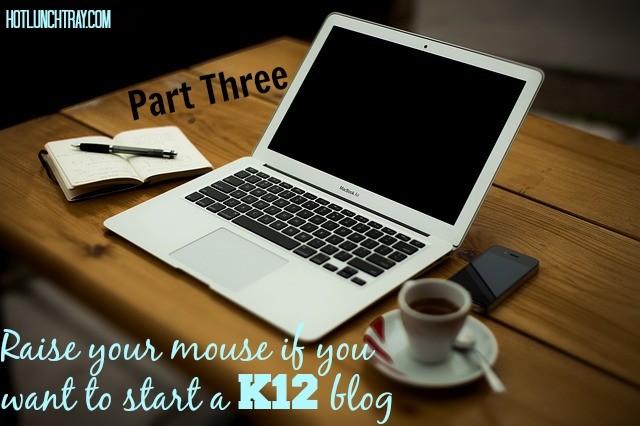 You want to start blogging about K12?
You want to start blogging about K12?
So far from Part One and Part Two on Starting a K12 Blog you have started to think about your area of passion and have walked through the Getting Started Checklist to set-up your blogging platform. You have explored the content of your posts and considered the manner in which you format your posts. Hopefully you have even made an introductory post. If not maybe you want to read through the final installment of this blog series you are challenged to write a post when you are finished reading this.
Identify your Blogging Goals
A blog can evolve over time, so there is no need to rush into what your blog needs to be – and the good news is you can change your mind as well since it is your blog.Set your Purpose
Your goals for blogging may evolve over time and that is okay. However, it is helpful to articulate why you are starting so that you know how to start.
Who is your audience? Are you writing to educators, to parents, to policy makers, or yourself? The process of out ones thoughts to any of these audiences is likely to clarify your thoughts and beliefs around the topic. Such clarity of thought is potentially beneficial to more than just your intended audience.
What does that audience require to understand your thoughts and ideas? The jargon of education is sometimes a barrier for non-educators to overcome. Differing levels of educators (think new teachers) may require more examples, and non-examples, than others. Chances are you have a good idea what differing audiences are looking for, but you cannot deliver it without first identifying that audience.
“Why?” may be an evolving question to answer – however – you can always change your mind later.
Sharing Posts
I blogged about a Google Hangout on Air recently where an organizer categorized initial blog posts as potentially, “sharing out to the void and posting to no one and everyone at the same time” and if you are not completely settled on your purpose and audience I can see how it might feel that way. So how can you share to others that give you feedback?
…initial blog posts as potentially, “sharing out to the void and posting to no one and everyone at the same time”
Share your content via the social media outlet of your choice. Twitter is huge with educators, but Facebook can reach across your different spheres of influence and let people know you at a deeper level than just another Facebook quiz.
How can you start sharing via social media? IFTTT.com is an excellent way for you to automate your blog posts to social media (and your life to some extent). WordPress plugins such as Digg Digg will allow readers to share your content via your blog. You can link your Google+ profile to your WordPress blog for instant posts. Both IFTTT and Google+ will also show in the Digg Digg numbers, which sort of seed the idea that this content is good enough to share! If social media is something you are interested in look into securing a Twitter handle, Facebook page, Pinterest page/boards with your name as soon as possible.
Really Simple Syndication (RSS) is a feed or either posts, comments, or both which you can follow. Aggregators such as Feedly and Bloglovin attempt to wrap these RSS feeds which you gather into a readable format to read in bulk at a time you choose. By making it easy for others to add you to aggregators or advertising your RSS you can gather more readers.
Reading other blogs you may eventually find kindred spirits in the blogosphere. The surest way to make friends is to leave meaningful comments and include a link back to your blog. Blogs which utilize the CommentLuv plugin automatically pull a posters most recent post.
Concerned about Traffic?
One of the reasons some start blogging is to make money off the traffic their blog generates. You may just want to increase your influence. Either way aside from the previously mentioned sharing options consider these future strategies to employ: nrelate plugin suggests other posts (matched up by tags) to your readers, asking to guest blog for blogs you really like and accepting guest blogger to cross-pollinate blog links/traffic, and investigate how collecting emails might be accomplished on your blog inline with your philosophy.
If you are serious about your online blog presences it may be time to consider Google Analytics which can help you gain a demographic view of your readership and help you with your Search Engine Optimization (SEO). When you are ready to see where you rank in educational blogs, submit your URL to teach100.com and be ranked against other educational blogs. The largest component of the ranking is social at 40% “… as determined through its combined Facebook shares, Tweets and StumbleUpon visits to the blog and its most recent posts. Ranking weighs shares pointing back to the blogs 10 most recent posts as well as for its main domain.”
Your Call to Action
You now have all the basic steps to consider and take to start a blog. You have considered content, format, and purpose and are now as ready as anyone else to create your first blog post. Review anything in this series of posts by clicking on the tag #K12blog, but do it now!
I would love to connect with your blog, so please comment and let me know when you have put yourself out here!






1 Pingback